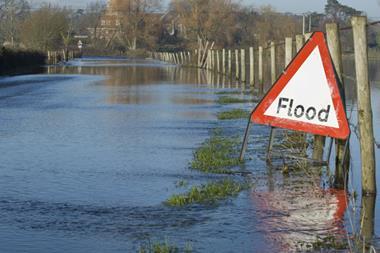Industry commentators believe the decrease is partly a result of work done by the UK government and flood resilience schemes
Claims for flood damage have reduced over the last five years despite a rise in rainfall, according Go.Compare Home Insurance.

The price comparison website (PCW) revealed this week (12 April 2023) that it provided 3,448 home insurance quotes for properties that had previously claimed for flood damage in 2017 – this reduced by 30% in 2022.
A similar trend could also be seen in the number home insurance quotes that had previously claimed for storm damage, which dropped by over 20% to 14,926 in 2022 from 19,284 in 2017.
This was despite the Met Office highlighting in its Effects of climate change page that the UK had seen “six of the ten wettest years on record” since 1998.
However, the Envrionment Agency announced in 2021 that more than 300,000 homes were better protected from the effects of climate change compared with 2015.
Mary Long-Dhonau OBE, founder of Mary Dhonau Associates (MDA) Flood Resilience Consultants, said: “The government has doubled its investment in flood risk management and there’s also been a large increase in property flood resilience schemes, which will have reduced claims.
“But, this is in combination with other factors.”
Government initiatives
Flood Re was established in April 2016 as a joint initiative between the UK government and the insurance industry to improve the affordability and availability of flood insurance for homes across the UK.
As of September 2022, 94% of homes surveyed with a flood claim in the last five years could obtain a quote from ten or more brands across two PCWs.
Previously, only 9% of home could get quotes from two or more insurers – this reduced to 0% from five or more insurers.
As part of the scheme, Flood Re launched Build Back Better in April 2022, which offers householders the opportunity to install property flood resilience measures up to the value of £10,000 after the event of a flood to prevent future flood damage.
Surface flooding
Despite the decrease in claims, Long-Dhonau explained that “climate change is here and flood risk will continue to increase, especially surface water flooding”.
“Clouds are now heavier and move more slowly, [which] means they stay and drop their contents in one localised area – this type of flash flooding is much harder to predict”, she said.
Read: Briefing - Insurers facing flood dilemma as new models remove all doubt
Read: Flood Re completes East Peckham pilot to score properties’ flood resilience
Explore more sustainability-related content here or discover other news stories here
The National Infrastructure Commission’s Reducing the risk of surface water flooding report, published November 2022, showed that around 325,000 English properties were situated in areas at the highest risk of surface flooding.
In July 2021, widespread flooding in London affected over 1,500 properties, as well as health infrastructure and transport networks.
Go.Compare’s home insurance expert Ceri McMillan therefore stressed the importance of insured’s understanding and uptake of flood insurance, even in areas that were not at high risk.
”Even if you don’t live in a high risk area, it’s best to be covered for all eventualities,” McMillan added.
”Flood insurance is included as part of any standard home insurance policy, so you won’t need to take out extra cover, but you’ll be protected from any damage or loss in the event of a flood.”












































No comments yet